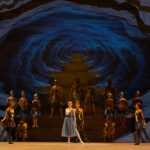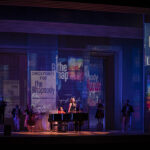
Thom Weaver’s Lighting Plays a Key Role in Macbeth, Fun Home
Is there a “normal” way to interpret Shakespeare in 21st century theater? The days of recreating Elizabethan England seem to be behind us, as today’s directors place their productions anywhere they like and use the Bard’s intricate language and story lines to create a new take on centuries-old material. In recent memory, we’ve seen an all-female production of Twelfth Night set in the roaring 1920s, A Midsummer Night’s Dream on post-apocalyptic Earth, and The Taming of the Shrew as part of a traveling circus… and that’s just in theaters around upstate New York.
So when Chicago Shakespeare Theatre (CST) approached its own Macbeth earlier this year, no one was surprised to learn that this production would not take a traditional approach. Instead, the Scottish play would become a supernatural horror thriller, complete with magical illusions created by the top person in the illusion business. The management turned to a directing team that had mounted a mystical interpretation of The Tempest in 2015: Helen Hayes Award-winning director Aaron Posner, and Teller — the silent half of Penn and Teller, the world-famous illusionist team.
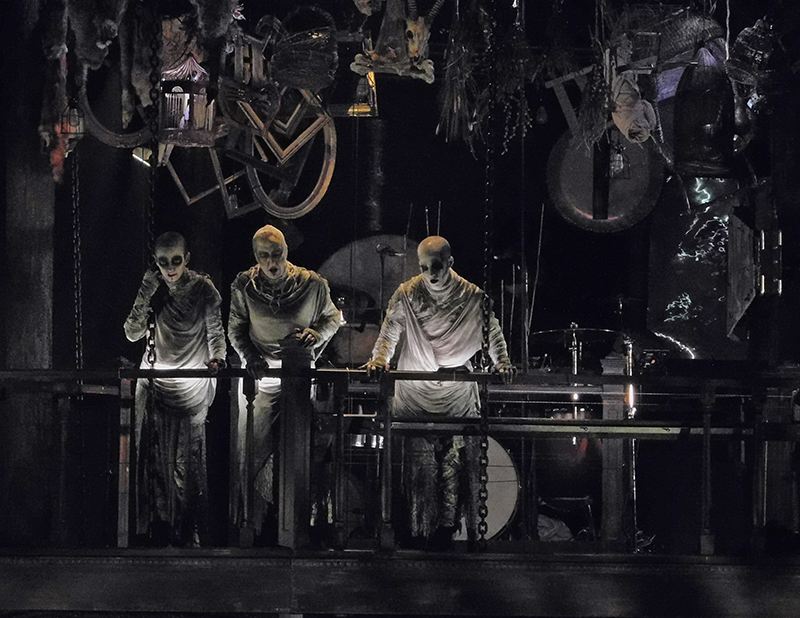
“Nothing Is, But What Is Not”
When asked by theater staff what language in Macbeth carries the play’s central idea, Posner chose the lines, “Nothing is, but what is not,” and “Fair is foul, and foul is fair.”
“What’s illusion and what’s real? Those lines have shaped our entire approach to the play,” he said, in a Q&A in the show’s program.
Teller explained his approach as well: “There are six major magical sequences in Macbeth. We are doing magic that is necessary; we are creating the complexity of their difficult mind-state, and making the world unreliable through magic.”
This, in a nutshell, created a monumental challenge for lighting designer Thom Weaver, who would play a significant role in enhancing the illusions throughout the production.
“It was one of the hardest things I’ve done in a long time,” he said. “I spent a month there, which is a long time for a lighting designer to be in one place for a show.”
Weaver had worked with this directing team before, so he knew what to expect — but the surreal nature of this production required a heightened level of precision. “The principal context was horror, really highlighting the supernatural horror of the play, and that created a whole framing device for the entire design, because it allowed for dramatic shifts and reframing of things,” he said. “It created a whole new kind of tempo. We imagined it as a world in which the sisters were very much in control, guiding the proceedings, enjoying the results as they came.”
This informed Daniel Conway’s scenic design as well, Weaver noted. “It gave the whole surrounding a life — it was more than just architecture, a kind of supernatural organism that surrounded them at all times. That gave us the ability to have events magically happen, things appear and disappear.”
Much of the process of creating illusions relies on misdirection of the audience’s attention, and lighting can assist with this, Weaver said. “Teller once said to me that magic is pass-fail. There’s no such thing as an okay magic trick. It must be meticulous. The illusions are very dependent on lighting — whether they’re hiding something or creating the emotional context for the event. So it’s a very time-consuming process. It’s usually a very long and very exciting workday with Teller. He’s always looking to make everything just a little better.”

Changing the Universe in an Instant
Weaver, a graduate of both Carnegie-Mellon and Yale universities, sees his contribution as the creation of universes with his lighting designs. “I make large proposals of what I think the universe is, based on the production of the piece and the staging and the performers. I try to synthesize this into a bold proposal. Through the dialectic of collaboration, we come to an understanding of what this universe is.”
In the case of Macbeth, however, he had to go beyond his universe, using his lighting as the “prover” to enhance the illusion. “The prover is when the magician shows you the inside of the hat,” he said — the moment in which the audience is led to believe everything is normal. An instant later, they are taken in by the illusion. “So we establish the universe, and then we re-establish it in another iteration, but it seems like the same world. That’s not an easy thing to do.”
To change the world in the blink of an eye, Weaver employed all the LED lights in the theater’s inventory. “LEDs give you incident control and instantaneous switches of color that make for really exciting, unexpected events happening — a lot of light coming from places it shouldn’t, or being lit from embedded LED sources in the railing in the attic. There was a lot of hidden detail in the set. Sconces that changed color. The cauldron alone had its own light plot.”
Weaver couldn’t reveal the secrets behind any of the play’s illusions, of course, but he cited the moment Banquo’s ghost appears as a hallmark of lighting’s role. “Banquo appeared first in this yellow down light, and then we changed the world and re-introduced the down light, and he appeared somewhere else,” he said. “There was a lot of crowd misdirection in that, and it required me to have some really dramatic lighting shifts that were just red herrings.”
Teller’s secrets remain so, though Weaver hinted at his own process. “The illusion is always returning to the same world over and over again,” he said. “Like something is hidden, but when you return to the first universe, you see that it’s not. The set was so open, there was no place really for anyone to hide. So in part of the trick, you remain unconsciously focused on one area of the stage, and then Banquo can pop out somewhere else. It’s very strategic.”
To achieve the desired effects, Weaver made strategic use of a new LED automated light, Martin’s MAC Encore Performance CLD. It employs LED technology and a proprietary engine that provides full-spectrum light with unusually exacting color rendition, from 6000K neutral daylight to a full palette of colors, from pastels to saturated washes. “It’s an amazing, versatile light, and it’s silent,” says Weaver. “It had a place in an enormous spectacle production like Macbeth, and I’ll use it in quiet shows as well. The resolution was unbelievable.”
Taking part in the illusions posed one challenge after another for Weaver, but he also kept his focus on the overall design and its ability to create a world for Macbeth’s own emotional descent. “I had to create the l’appel du vide — the call of the void, that weird sensation that makes you want to jump off a bridge, the beat that was calling to Macbeth at all times,” he said. “So much of what we were doing was inspired by horror, but I would argue that true horror is only terrifying if it is a manifestation of what’s inside of you. If you can embed the kind of spectacle that we had in all of that, then you’ve got yourself a really compelling idea of Macbeth. It’s about what lurks in the shadows, and my job was the shadows.”
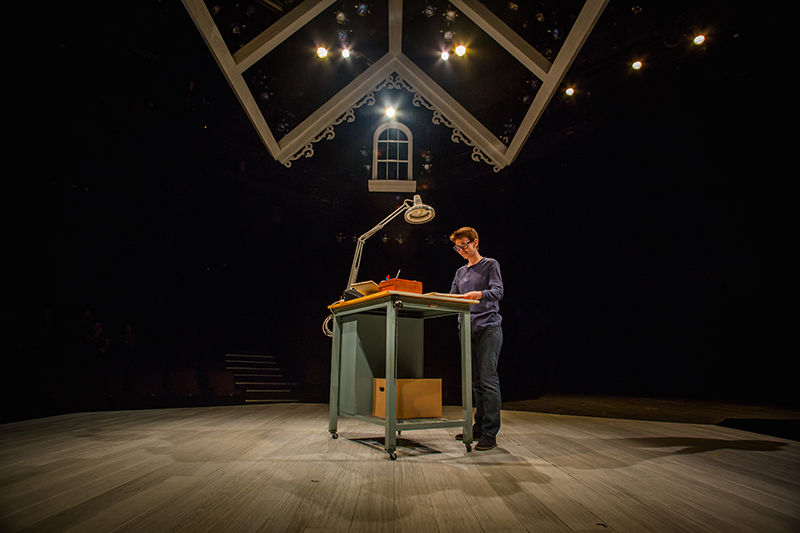
And Then…a Suburban Family Musical
After an epic experience on a creepy Shakespearian horror drama, what was next on Weaver’s always-packed docket? Something at the other end of the spectrum: a production at the Arden Theatre in Philadelphia of the Tony Award-winning musical Fun Home, the musical adaptation of cartoonist Alison Bechdel’s graphic memoir about a young lesbian growing up with a closeted gay father.
“I was at a design run of Fun Home two days after we opened Macbeth,” said Weaver. The two shows could not have been more different, and this suited Weaver just fine. “The simplicity of Fun Home was what I was really focused on. I went with the most simplistic, binary approach that was available to me.”
The musical details the making of Bechdel’s graphic novel, as she looks back at the events that led her to tell her story in a comic book format. “I created two different color fields. The older Alison lives in a warmer, incandescent world, while her family in the 1970s is in a cooler, white world. We established the color palette right away, and that allowed it to have much more impact. Being rigorous with that dramaturgical idea, there can be an intersection of those two universes in a very meaningful and impactful way.”
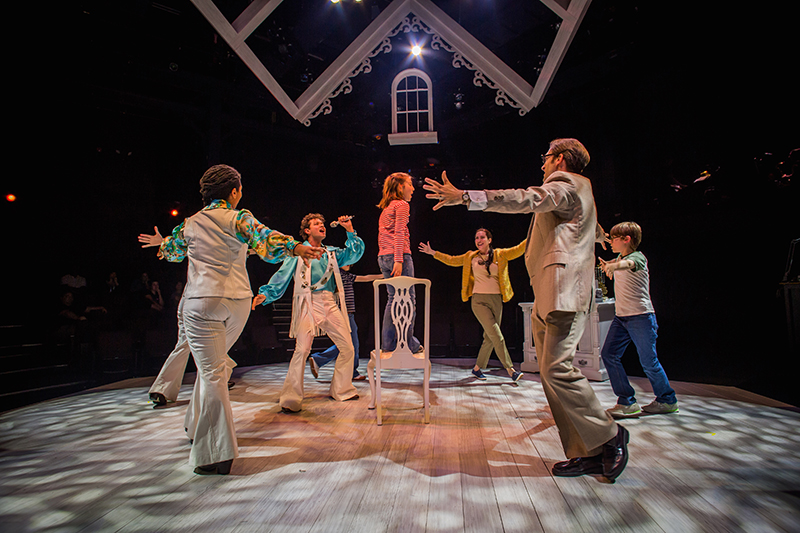
Working within this comparative simplicity, Weaver’s lighting enhanced the emotional impact of the play as well, a powerful message that he felt deeply. “It was hard to do my job during previews, because I was crying every night,” he admitted. “It was wonderful in that sense.”
Again, the MAC Encore CLD turned out to be just what Weaver required. “In Fun Home, I couldn’t use followspots,” he says. “We had been assuming followspots for some time, and then I realized I couldn’t do it. Followspots become the manifestation of the audience’s lens, the outside looking in. Since I couldn’t have them, I had to rethink that — so I used the MAC Encore lights, and I was very excited about the results.”
Perhaps his approach stems from his lifelong connection to the theater — his parents are drama teachers, his sister is an actor, and he himself began designing lighting as a teenager — or maybe it comes from his experiences as an intern in Philadelphia, or his relationships with mentors in New York City. Whatever the source, Weaver brings a forthright and collaborative approach to his work, no matter what kind of play may be on stage.
“I reject the idea of ‘servitude,’” he said. “Every time I hear, ‘We’re here to serve the play,’ it makes me nervous. We’re creating a universe, and we create it together. It seems to me that’s the real purpose of collaboration. When I walk into the space, I have a vision of what it can be, and it seems criminal not to try and share that vision. It can inform what we are doing.”
